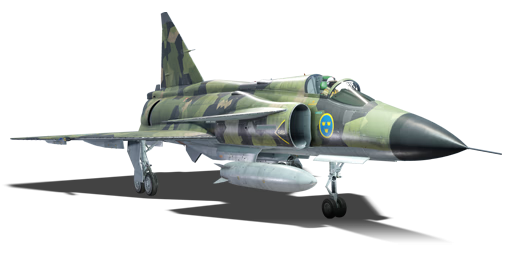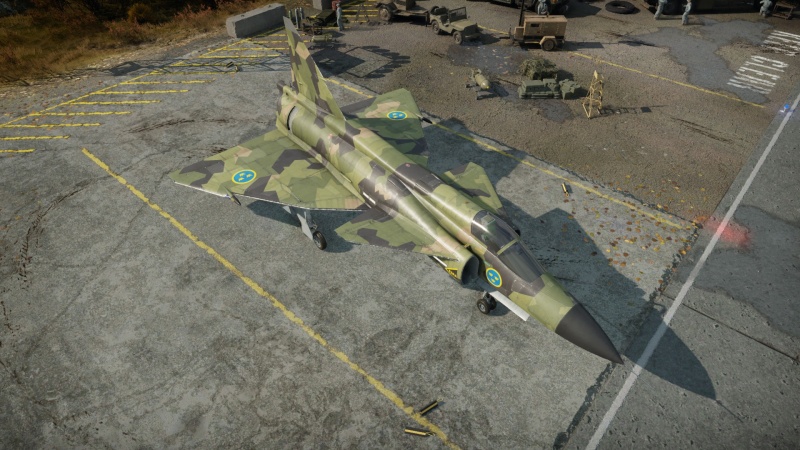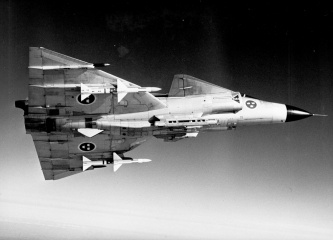JA37C
Contents
Description
The JA37C Jaktviggen is a rank VII Swedish jet fighter with a battle rating of 11.0 (AB) and 11.3 (RB/SB). It was introduced in Update "Direct Hit".
General info
Flight performance
Describe how the aircraft behaves in the air. Speed, manoeuvrability, acceleration and allowable loads - these are the most important characteristics of the vehicle.
| Characteristics | Max Speed (km/h at 9,000 m) |
Max altitude (metres) |
Turn time (seconds) |
Rate of climb (metres/second) |
Take-off run (metres) | |||
|---|---|---|---|---|---|---|---|---|
| AB | RB | AB | RB | AB | RB | |||
| Stock | 1920 | 1874 | 14500 | 26.1 | 26.4 | 169.2 | 158.8 | 900 |
| Upgraded | ___ | ___ | __._ | __._ | __._ | __._ | ||
Details
| Features | |||||
|---|---|---|---|---|---|
| Combat flaps | Take-off flaps | Landing flaps | Air brakes | Arrestor gear | Drogue chute |
| _ | _ | _ | _ | _ | _ |
| Limits | ||||||
|---|---|---|---|---|---|---|
| Wings (km/h) | Gear (km/h) | Flaps (km/h) | Max Static G | |||
| Combat | Take-off | Landing | + | - | ||
| 0 | 620 | ___ | ___ | ___ | ~__ | ~__ |
| Optimal velocities (km/h) | |||
|---|---|---|---|
| Ailerons | Rudder | Elevators | Radiator |
| < ___ | < ___ | < ___ | N/A |
Engine performance
| Engine | Aircraft mass | |||||
|---|---|---|---|---|---|---|
| Engine name | Number | Basic mass | Wing loading (full fuel) | |||
| Svenska Flygmotor
RM8B |
1 | _,___ kg | ___ kg/m2 | |||
| Engine characteristics | Mass with fuel (no weapons load) | Max Takeoff Weight | ||||
| Weight (each) | Type | _m fuel | __m fuel | __m fuel | ||
| ___ kg | _____ | _,___ kg | _,___ kg | _,___ kg | _,___ kg | |
| Maximum engine thrust @ 0 m (RB/SB) | Thrust to weight ratio @ 0 m (___%/WEP) | |||||
| Condition | 100% | ___%/WEP | _m fuel | __m fuel | __m fuel | MTOW |
| Stationary | ___ kgf | ___ kgf | _.__ | _.__ | _.__ | _.__ |
| Optimal | ___ kgf (_ km/h) |
___ kgf (_ km/h) |
_.__ | _.__ | _.__ | _.__ |
Survivability and armour
Examine the survivability of the aircraft. Note how vulnerable the structure is and how secure the pilot is, whether the fuel tanks are armoured, etc. Describe the armour, if there is any, and also mention the vulnerability of other critical aircraft systems.
Modifications and economy
Armaments
Offensive armament
The JA37C is armed with:
- 1 x 30 mm Akan m/75 cannon, belly-mounted (150 rpg)
Suspended armament
The JA37C can be outfitted with the following ordnance:
- Without load
- 2 x RB24 missiles
- 6 x RB24 missiles
- 6 x RB24J missiles
- 2 x RB71 missiles
- 2 x RB71 missiles + 4 x RB24 missiles
- 2 x RB71 missiles + 4 x RB24J missiles
- 24 x psrak m/70 rockets
- 24 x psrak m/70 rockets + 2 x RB24 missiles
- 24 x psrak m/70 rockets + 2 x RB24J missiles
- 12 x psrak m/70 rockets + 2 x RB71 missiles + 2 x RB24 missiles
- 12 x psrak m/70 rockets + 2 x RB71 missiles + 2 x RB24J missiles
Usage in battles
Describe the tactics of playing in the aircraft, the features of using aircraft in a team and advice on tactics. Refrain from creating a "guide" - do not impose a single point of view, but instead, give the reader food for thought. Examine the most dangerous enemies and give recommendations on fighting them. If necessary, note the specifics of the game in different modes (AB, RB, SB).
Pros and cons
Pros:
- Possible the fasted aircraft in the game at sea level; can accelerate up to Mach 1.21.
- Strong energy retention
- Great agility - Responsive elevons and a large rudder
- Impressive and low stall-speed
- Strong firepower - 30 mm gun shreds everything it hits
- Agile RB71 missiles
- Good air-to-air payload - Up to 6 missile pylons
- Access to countermeasures
- Easy to land - Strong landing gear and access to reverse thrust
- Strong air-to-air radar with access to pulse doppler tracking
Cons:
- Very high fuel consumption
- Mediocre acceleration
- Weak air-brakes - Difficult to slow down in the air
- Sluggish at lower speeds
- Low ammo count, lacks access to tracer munitions
- Unconventional flaps - Mostly useful during landings
History
Background
During the 1960s, advances in technology occurred rapidly alongside the aviation industry, paving the way for more complex and capable designs. In order to keep up with the rest of the industry, SAAB had to develop aircraft at a constant pace, often coming up with replacements before the predecessor had even entered service. The SAAB Viggen was sought to be the replacement for the A32A and was being considered as early as 1952. The decision of whether to make a fighter or attacker design continued for years. By the end of the '50s, project 1500 started to show potential, with a delta wing design capable of performing multiple roles through different versions. The wing design would allow for short-distance take-off and landings, following the BAS60 roadbase system requirements. These also included all-weather capability and full coverage of the 2,000 km Swedish coastline.
The 37-1 prototype took to the skies in February of 1967. The design still had to go through extensive modifying before the plane could reach the production line. The canards were angled, the wing adjusted, and the fuselage bent slightly. Much of the unorthodox appearance of the Viggen arrived from the extensive testing done on the first prototypes. When finalized, an order of AJ37 Viggens was handed over to F7 Skaraborg, becoming the first division utilizing the aircraft.
JA37
With the Viggen successfully replacing ageing attack and reconnaissance aircraft, the focus shifted towards the replacement of the J35 Draken. This required extensive modifying of the Viggen as a whole, as the requirements for an interceptor wouldn't be met with the powerplant and avionics used in the already existing variants. The project was extensive, redesigning most areas of the plane to fit these specifications. SAAB had to fit an internal gun, an air-to-air radar, and a new flight computer which allowed a real-time data-feed between ground stations and flight groups. One of the more complicated adjustments was the powerplant, where the engineers had to install an additional fan stage. This helped counteract the compressor stall the RM8 engine often experienced at high angles of attack, allowing the JA37 to dogfight more comfortably. These modifications were expensive, exceeding the set budget several times. But SAAB pressed on with the design until the version was fully developed.
The first completed JA37 flew on November 4th, 1977. The first service variants were delivered to F13 Bråvalla in June of 1980, while F17 Blekinge and F21 Luleå received theirs in 1981 and 1982 respectively. The JA37 would go on to be the most produced variant of the Viggen, with 147 aircraft delivered between eight different divisions. The JA37 was highly appreciated by those who flew it, and saw many modifications that extended its lifespan.
JA37C
As the 80s came to an end, the Viggen platform began to require an overhaul to bring the capabilities closer to that of other countries. The Gripen project was still years away from being completed, so an upgrade program began that would involve all JA37 in continued service being upgraded to the JA37C standard. This package introduced countermeasures, and a new signal processor, allowing the radar to track more efficiently against enemy jamming. The radar could now follow multiple targets simultaneously and also display virtual targets to enhance pilot training. This variant of the JA37 would see use up until the end of the decade, still being a capable platform for its time.
Devblog
The requirements for a new aircraft with very high performance to replace the SAAB 35 Draken emerged in the early 1960s. In 1962, the design team of the SAAB company prepared a draft design of the SAAB 37 aircraft, built according to an exotic double delta wing. The project seemed interesting for military authorities , and SAAB received funding to fully develop a new fighter in four basic configurations. The last and most advanced version was the SAAB JA37 Jaktviggen fighter-interceptor, the development of which continued until the mid-1970s, which was associated with the improvement of the engine and the development of modern electronic equipment. The first flight of the experimental JA37 interceptor fighter took place in June 1974, and in 1979 the fighter began to be supplied for service. Until 1990, 149 JA37 Jaktviggen units were produced. The specific appearance made the aircraft of the J37 family a "calling card" of the Royal Swedish Air Force for a long time.
Media
Excellent additions to the article would be video guides, screenshots from the game, and photos.
See also
Links to the articles on the War Thunder Wiki that you think will be useful for the reader, for example:
- reference to the series of the aircraft;
- links to approximate analogues of other nations and research trees.
External links
Paste links to sources and external resources, such as:
- topic on the official game forum;
- other literature.
| Swedish Aeroplane Company Ltd. (SAAB) | |
|---|---|
| Pre-SAAB: SA / ASJA | |
| SA 'Jaktfalken' | J6B |
| SAAB 17 | B17A · B17B · S17BS |
| SAAB 18 | B18A · B18B · T18B · T18B (57) |
| SAAB 21 | J21A-1 · J21A-2 · A21A-3 · J21RA · A21RB |
| SAAB 29 'Tunnan' | J29A · A29B · J29D · J29F |
| SAAB 32 'Lansen' | J32B · A32A · A32A Röd Adam |
| SAAB 35 'Draken' | J35A · J35D |
| SAAB 37 'Viggen' | JA37C · JA37D · JA37DI · JA37DI F21 · AJ37 · AJS37 |
| SAAB 39 'Gripen' | JAS39A · JAS39C |
| SAAB 105 | SK60B · SAAB-105G |
| License Production | B3C (Ju 86K) |
| Export | SAAB-105OE · J35XS · ▄JAS39C · ◔JAS39EBS HU C |
| Sweden jet aircraft | |
|---|---|
| Fighters | J21RA |
| J29A · A29B · J29D · J29F | |
| J32B | |
| J34 | |
| J35A · J35D | |
| JA37C · JA37D · JA37DI · JA37DI F21 | |
| JAS39A · JAS39C | |
| Strike aircraft | A21RB |
| A32A · A32A Röd Adam | |
| A28B | |
| AJ37 · AJS37 | |
| SK60B · SAAB-105G | |
| Export | SAAB-105OE |
| Finland | ▄Vampire FB 52A · ▄MiG-21bis · Saab J35XS |






